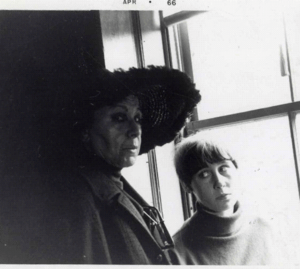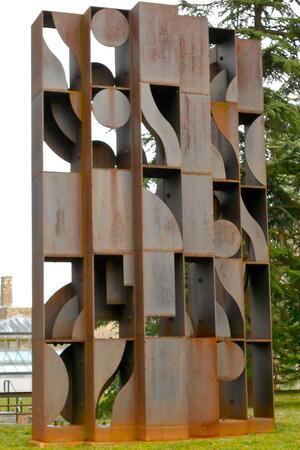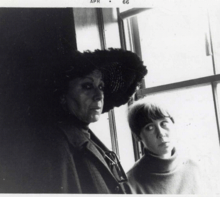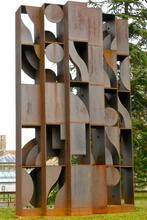Louise Nevelson
Louise Nevelson created sculptures that audiences could both experience and see. Nevelson studied modernist and cubist styles in Munich. To support herself, she began teaching for the Education Alliance School of Art in New York in 1937. She boldly marched into the famed Nierendorf Gallery in 1941 and demanded an exhibition, gaining the gallery director’s representation and four solo shows on the strength of her work. In the 1950s, she began working with massive wall installations using found pieces of wood that were collaged in geometric grids and covered in paint for a uniform look, emphasizing the relationship of the shapes to one another. Several of these pieces are now owned by the Whitney, the Brooklyn Museum, and MOMA.
If an object is in the right place, it is enhanced to grandeur. More than that, it pleases the inner being and that, I think, is very important. That equals harmony.
Nevelson and Abstract Expressionists
Louise Nevelson belongs to a generation of Manhattan-based painters and sculptors who were born at the close of the nineteenth century and whose careers spanned the twentieth, coinciding with the development of modernism in America. Like several of the artists who later became known as abstract expressionist painters and sculptors, in the 1920s Nevelson traveled to Paris and also studied in New York at the Art Students League. In the 1930s, she worked under the auspices of the Federal Art Project of the Works Progress Administration, which allowed her and her colleagues an important opportunity to earn a salary for making and teaching art. The WPA also provided a forum for artists to meet and exchange ideas while acquiring professional credentials. It was in the late 1940s and during the 1950s that modernism came into its own in the United States, and artists who had been working steadily through the 1920s and 1930s developed a mature style. Each of these artists combined the predominant avant-garde influences of cubism and surrealism (imported to New York by European exiles from World War II) as well as the writings of Carl Jung, Sigmund Freud, and Jean-Paul Sartre with their own personal concerns to create the distinctive works for which they are best known. Jackson Pollock’s experiments culminated in the famous “drip” paintings, Mark Rothko painted fields of atmospheric color on monumental canvases, and Louise Nevelson’s tabletop sculptures collaged from found pieces of wood metamorphosed first into wall sculptures and finally into total environments.
Early Life and Family
Louise Nevelson was born Leah Berliawsky on September 23, 1900, in Pereyaslav, fifty miles southeast of Kiev. Nevelson’s father, Isaac Berliawsky, was born in 1871 in Pereyaslav. Her mother, Minna Ziesel (Smolerank) Berliawsky, was born in 1877 in the village of Shusneky. Louise was one of four children. The family emigrated in 1905 from Russia to Rockland, Maine. When they arrived in the United States, a cousin helped them to Anglicize their names. Thus, Louise’s brother Nachman became Nathan (Nate), her sister Chaya became Annie, and the following year another sister, Lillian, was born.
The transition from (Yiddish) Small-town Jewish community in Eastern Europe.shtetl life in Russia to a small, Anglo-Saxon community in rural Maine was not an easy one. The Berliawskys were Orthodox Jews who spoke Yiddish at home. However, they seem to have been isolated even from the community of two dozen Jewish families who lived in Rockland at the time. Minna Berliawsky suffered the most, unable ever to acclimate fully. Isaac Berliawsky began as a junk dealer and tradesman, eventually becoming an influential landowner and builder in Rockland. Education was emphasized in the household for the daughters as well as the son. Nate was in fact more athlete and entrepreneur than scholar, and did not finish high school. He was, however, eventually successful in business, running the Thorndike Hotel in Rockland for many years. Like his mother and sisters, Nate supported Louise with gifts of money during her leaner years in New York.
Louise excelled in her art classes in high school and resolved to attend Pratt Institute in New York, as several of her teachers had done, after graduation. However, when presented with the opportunity to marry the wealthy businessman Charles Nevelson and move to New York as a society matron rather than alone as a poor student, she did not hesitate to do so. The Nevelsons were German-speaking Latvian Jews from Riga. Charles was a partner in the Nevelson Brothers Shipping Company, based in New York. After a honeymoon in Cuba, the Nevelsons settled at 300 Central Park West.
Early Career, Travel, and Personal Life
The 1920s were a turbulent time for Louise Nevelson, which marked her passage from a young matron to an unencumbered bohemian. Her only child, Myron (Mike) Irving Nevelson, was born February 23, 1922, in New York. Beginning with Mike’s birth, the Nevelson domestic situation worsened. Louise Nevelson was profoundly dissatisfied with marriage and motherhood, and Charles Nevelson was under significant stress because the once-successful Nevelson brothers’ company was experiencing cash flow problems. During this period Louise Nevelson studied at the Art Students League with Anne Goldthwaite, Theresa Bernstein, William Meyerwitz, and Kenneth Hayes Miller. In 1926, she studied theater with Princess Matchabelli, and began a lifelong study of religious philosophies and spiritualism. In particular, Louise Nevelson followed the teachings of Jiddu Krishnamurti. Like the technique of assemblage that Louise Nevelson would later develop as a means of self-expression, she cobbled together elements from various cultures, religions, and philosophies to arrive at a personal worldview.
In 1930 Louise Nevelson studied with Hilla Rebay, whose theory of non-objective art was concerned with the link between spiritual concepts and formal aesthetics.
In 1931, Nevelson went to Munich to study with the well-known modernist painter Hans Hofmann. The political climate in Germany was already uncomfortable for avant-garde artists as well as for Jews, but Nevelson nevertheless counted the experience of studying in Munich a formative one. It was there that she first came in contact with Hofmann’s ideas of the “push and pull” of balanced composition, and with cubism, which she said “gave her the key to stability.” The element of cubism that Nevelson adopted for her own was the structuring of abstract compositional elements within a geometric grid. This method lent an order to the chaos of the found materials Nevelson later accumulated for sculpture, and for the broad, improvised gestures she used in her lithographs and etchings.
Tiring of Munich, Nevelson traveled around Europe, working as an extra in films in Vienna and Berlin. Back in New York in 1932, she joined Diego Rivera’s Rockefeller Center mural project, but she did not lend much practical assistance. When the mural was destroyed by its patron for inflammatory communist content, Nevelson did not participate in the subsequent artist boycotts or protests. If the prevailing concern in intellectual and artistic circles during the 1930s was commitment to social change, Louise Nevelson was in this regard out of step with her contemporaries. The most lasting lesson Nevelson seems to have taken from her time with Rivera was the model of a charismatic leader surrounded by enthusiastic followers. In her later years, Louise Nevelson succeeded in surrounding herself with an army of assistants—artists, students, and friends—who worked in her studio for a few days, weeks, or years, for as long as they were content to serve as subjects in an artistic monarchy.
In 1935, Louise Nevelson showed her work for the first time in a museum exhibition, Young Sculptors, at the Brooklyn Museum. Her work during the 1930s was composed largely of small semi-abstract figures modeled in clay. In 1937, she landed her first and only steady job, as a WPA-funded teacher at the Educational Alliance School of Art.
Work in the 1940s and 1950s
The 1940s were a time of building foundations for Louise Nevelson. In a now-famous encounter she marched into the prestigious Nierendorf Gallery one day in 1941 to demand an exhibition from the gallery director. After a studio visit, Karl Nierendorf agreed to represent her, and in September of that year she had her first of four solo shows with him. Although no works were sold from these early exhibitions, they received positive reviews and her relationship with Nierendorf greatly enhanced Louise Nevelson’s visibility. She was discouraged by the lack of sales, however, and ended up destroying much of the work. With the help of Nierendorf and funds inherited upon the deaths of her parents (Minna Berliawsky died in 1943, and Isaac Berliawsky in 1946), Nevelson purchased a house on East 30th Street. Having lived in a series of small shared apartments following her separation and eventual divorce from Charles Nevelson, a house and studio of her own marked an important achievement for her as an independent person and as an artist. In 1947, Karl Nierendorf died unexpectedly, depriving Nevelson of her staunchest supporter. In response to these losses, Nevelson became withdrawn, crafting small black boxes with velvet interiors, and exhibiting very rarely. The three themes that scholar Laurie Simon has identified as central to Nevelson’s iconography—royalty, marriage, and death—came to the fore in the late 1940s and remained important throughout her career.
In 1949–1950, Louise Nevelson made two trips to Mexico. She was affected by the monumental and totemic qualities of Maya art, elements of which she subsequently incorporated into her own work. Two etchings made shortly after her return demonstrate how Nevelson synthesized a surrealist interest in dream imagery, her experience of Maya art, and her own preoccupations with royalty (she considered herself to have queenly qualities), marriage (to her work), and death (real and symbolic). The totemic figures in The King and Queen and the mystical space of Magic Garden, two etchings completed in 1950 and 1951, respectively, were combined by Nevelson in her major sculptural environments of the 1950s.
Ancient Games and Ancient Places, exhibited at Grand Central Moderns Gallery in 1955 incorporated prints and sculptural works. The focal point of this exhibition was The Bride of the Black Moon, a wooden sculpture standing three and a half feet high (this work, like much of Nevelson’s production from the period, was later destroyed).
The aesthetic and psychological journeys Nevelson undertook in the years immediately following construction of The Bride of the Black Moon resulted in the following exhibitions: Royal Voyage, 1956; The Forest, 1957; Moon Garden + One, 1958; and Sky Columns Presence, 1959. Sky Cathedral, a component of Moon Garden + One, was Nevelson’s first wall sculpture. Composed of 116 stacked boxes enclosing architectural fragments, Sky Cathedral shifted the idea of sculpture as an object one walks around to an environment that surrounds the viewer. These works, all created from scavenged wood and dipped in vats of black house paint to create a uniform surface, addressed, both literally and metaphorically, feared and cherished memories. Nevelson gathered wooden refuse from old buildings and scavenged antique architectural elements rife with the personal histories of strangers and wove them into her own personal mythology and work.
The black environments earned Louise Nevelson her first substantial critical and public success. Through donations from the artist’s collectors, the Whitney Museum of American Art acquired Black Majesty, the Brooklyn Museum acquired First Personage, and the Museum of Modern Art acquired Sky Cathedral. Nevelson appeared in a Life magazine spread posing with Moon Garden + One in 1958. One of the most tangible rewards of recognition was Nevelson’s inclusion in a group show at the Museum of Modern Art in 1959. For this exhibition Nevelson created her first white environment, Dawn’s Wedding Feast.
Dawn’s Wedding Feast represented a kind of mystical cosmic marriage. For this installation, Nevelson created several anthropomorphic totems. Other sculptors in New York were experimenting with totemlike sculptures, among them Louise Bourgeois and David Smith, but the inclusion of sculptural walls in Nevelson’s environments of this period was both unique and influential. Dawn’s Wedding Feast transformed the gallery into a shrine. In this sense, Dawn’s Wedding Feast was important as an early example of what has come to be called installation work, but is also the first full realization of the type of spiritual environments that Nevelson was commissioned to create in the 1960s and 1970s for both Jewish temples and a Christian house of worship.
Later Career
In 1964 the Jewish Museum in New York acquired Nevelson’s wall sculpture Homage to 6,000,000 #1, and in 1965 the Israel Museum in Jerusalem acquired Homage to 6,000,000 #2. With the sobriety of their titles and the significance of their destinations, the relevance of Nevelson’s Jewish identity to these works seems clear enough. However, the formal language of the two versions of Homage to 6,000,000 does not differ significantly from contemporaneous works such as Sky Cathedral (1958) or An American Tribute to the British People (1960–1965). Nevelson was typically willing to weave any intriguing material into her personal myth, but she was notably reticent on the subject of her Jewish heritage. When questioned in interviews on this topic she replied that it was too personal to discuss. The spirituality of Louise Nevelson’s work might best be understood by considering her repeated emphasis on a search for harmony.
Saint Peter’s Lutheran Church in Manhattan commissioned Nevelson to design entirely the interior for their Chapel of the Good Shepherd. For this commission, the artist created a frieze of white wall sculptures referring to the twelve apostles and three suspended columns symbolizing the Trinity. At the front of the chapel, Nevelson hung from the ceiling a gilded abstract crucifix. In addition, she designed white vestments for the chapel clergy. When asked about designing a Christian chapel as a Jew, Nevelson replied, “To me there is no distinction between a church and a synagogue. If you go deep enough into any religion you arrive at the same point of harmony.”
In addition to constructing major works, Nevelson spent the 1960s and 1970s engaged in a campaign to expand her reputation in the artistic community. In 1962 alone, she held the following offices: president of National Artists Equity, vice president of the Federation of Modern Painters and Sculptors, member of the National Association of Women Artists, and member of the Sculptors Guild. In this decade she began her affiliation with Arnold Glimcher, who wrote her first major catalog and showed her work frequently at his Pace Gallery, first in Boston and then in New York.
Major commissions during the 1970s included a fifty-five-inch wooden wall for Temple Beth-El in Great Neck, New York (1970), and a sculpture commemorating the bicentennial of the United States for the federal courthouse in Philadelphia (1976). During this period, Nevelson explored the medium of Cor-Ten steel, a durable metal that rusts on the exterior but retains its internal integrity. In this medium, Nevelson was able to design numerous monumental outdoor works, including an exterior wall sculpture for Temple Israel, in Boston (1973); a black monumental work for the Embarcadero Center in San Francisco (1977); and perhaps her most successful steel sculpture, Atmosphere and Environment XIII: Windows to the West, for the city of Scottsdale, Arizona. In 1978, a small plot in lower Manhattan was renamed Louise Nevelson Square, and seven tree-shaped monumental steel pieces were installed there by the artist.
Legacy
In 1979, Louise Nevelson was elected a member of the American Academy and Institute of Arts and Letters in New York. In this capacity, she occupied the chair that was originally held by American sculptor Augustus Saint-Gaudens when the organization was founded in 1889.
Louise Nevelson died on April 17, 1988, at her home in New York City. Arnold Glimcher organized a memorial service and collected writings, which he later published, of remembrances from her friends.
Louise Nevelson continues to be eulogized after her death, most recently in the 1994 commemoration of the Nevelson-Berliawsky Gallery of 20th Century Art at the Farnsworth Art Museum in Nevelson’s hometown of Rockland, Maine. In Rockland, New York, and museums around the world her presence continues to be felt. Louise Nevelson took her identity as a Russian-born American Jewish woman artist and used it as raw material to construct both a myth and a body of work that speaks hyperbolically to the binary opposites of which she was made: extravagance and asceticism, clarity and confusion, darkness and light.
Albee, Edward. Louise Nevelson: Atmospheres and Environments (1980).
Anderson, Wayne. “American Sculpture: The Situation in the Fifties.” ArtForum (Summer 1967): 60–66.
Ashton, Dore. Art of the 20th Century: A Revelation (1982).
EJ.
EJ (1973-1982).
Friedman, Martin. Nevelson: Wood Sculptures (1973).
Glimcher, Arnold. Louise Nevelson (1972), and Louise Nevelson Remembered: Sculpture and Collages (1989).
Hughes, Robert. “Sculpture’s Queen Bee.” Time (January 12, 1981): 46+.
Krauss, Rosalind. Passages in Modern Sculpture (1977).
McAvoy, Susan Lane. Louise Nevelson: The Farnsworth Collection: An Exhibition Celebrating the Opening of the Nevelson-Berliawsky Gallery of 20th Century Art (1994).
MacKown, Donna. Dawns + Dusks: Louise Nevelson (1976).
Murray, Elizabeth. Artist’s Choice: Modern Women (1995).
Wilson, Laurie. “Bride of the Black Moon: An Iconographic Study of the Work of Louise Nevelson.” Arts (May 1980): 140–148.







